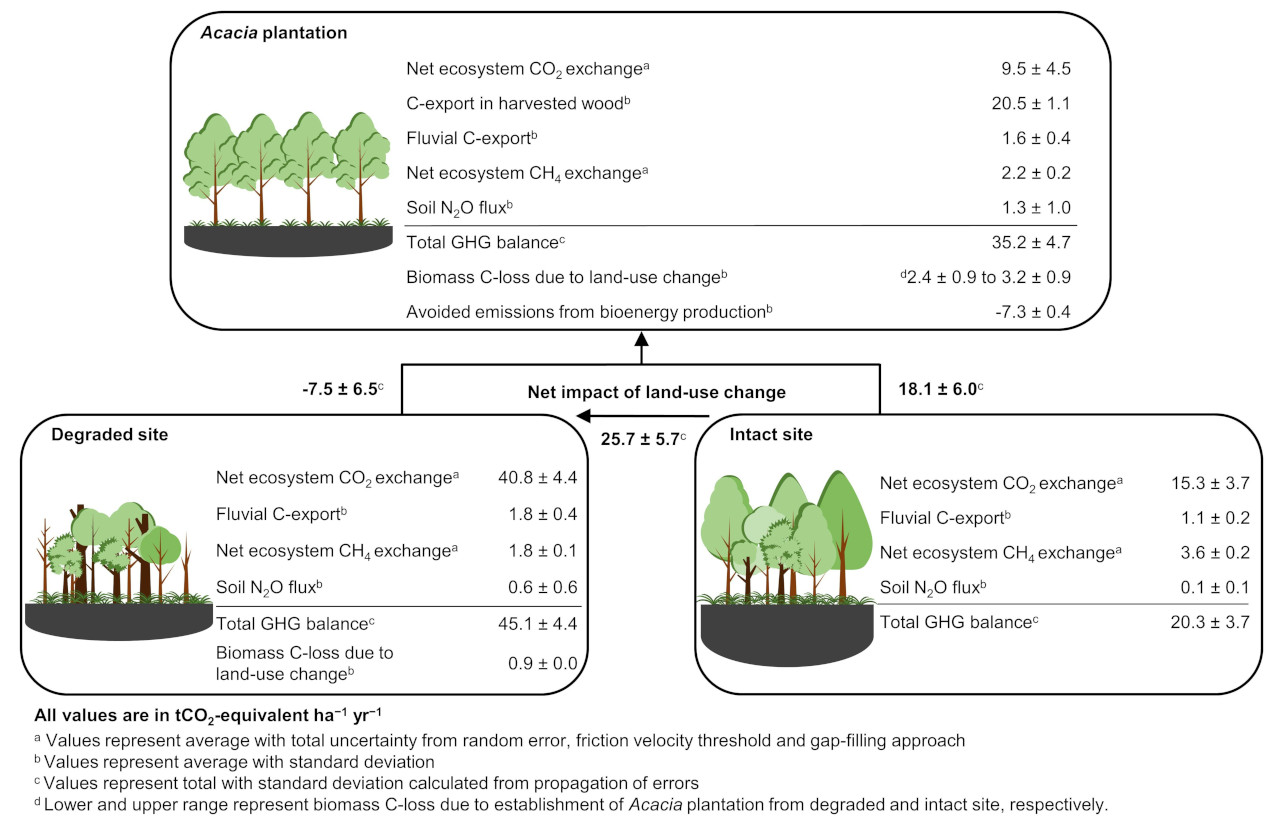Research on Effects of Land-Use Change on GHG Fluxes in Tropical Peatlands in Sumatra, Indonesia
Written by Dr Chandra S. Deshmukh, Greenhouse Gas Specialist, APRIL Peatland Science
Tropical peatlands are a critical ecosystem in regulating global carbon cycle and climate. While existing studies have shown that land use changes impact greenhouse gas (GHG) fluxes, the magnitudes of these effects remain uncertain, especially in tropical peatlands, owing to a dearth of high-quality measurements.
Given the role of tropical peatlands as nature-based mitigators of climate change, having reliable estimates of contemporary emissions and their relationship with controlling factors, can improve our understanding of their global climate impact, and support responsible peatland management and optimization of emissions mitigation measures.
Working alongside a team of respected global scientists, we recently completed a landmark study, published on 5th April 2023 in Nature, the world’s leading multidisciplinary science journal. The study has been undertaken over five years to better understand the estimates of net GHG fluxes associated with different uses of tropical peatland in Indonesia – including intact forest and Acacia fibre plantation.
Between October 2016 and May 2022, we measured GHG exchanges in intact forest, degraded forest, and Acacia crassicarpa tree plantations in the same peat landscape of Sumatra, Indonesia. We used the eddy-covariance technique to measure the net exchanges of carbon dioxide (CO2) and methane between the ecosystem and atmosphere, and tracked nitrous oxide flux in and out of the soil. Assuming that all harvested wood carbon will be returned to the atmosphere as CO2, the plantation’s CO2 emissions is calculated as the sum of net ecosystem CO2 exchange and harvested wood carbon export.
To our knowledge, this study is the first investigation of GHGs in any peatland-based fibre plantation globally to cover a full plantation-rotation period and encompassing all major GHG flux terms, including carbon loss due to plantation establishment, and the export of carbon in harvested wood and as dissolved carbon in rivers. The study then compared the results from the plantation with other long-term measurements from the degraded forest and intact forest sites to quantify the impact of land-use change on GHG fluxes. It also established associations between groundwater level and GHG fluxes.
The CO2 emissions from the plantation (fourth rotation, 17–22 years after drainage) were higher than those from intact forest, but lower than the current Intergovernmental Panel on Climate Change (IPCC) emission factor for plantations. The comparison between intact forest and Acacia plantation fluxes indicates that the conversion of intact forest to plantation results in a long-term net increase in GHG emissions of around 18 tCO2eq ha–1 year–1. But we observe that this is smaller than the increase associated with the degradation of intact forest (Fig. 1). As a by-product of pulp manufacturing, about 54% of the harvested wood from Acacia plantations is used to produce bioenergy. The calculated avoided emissions resulting from the use of tree biomass in place of coal burning is 7.3 tCO2-eq ha−1 year−1. This avoided emission through bioenergy production partly offsets the net increase in GHG emissions from the plantation itself.

Figure 1 | Effects of land-use change on greenhouse-gas balance in tropical peatlands in Sumatra, Indonesia
Our results confirm that conserving, restoring and responsibly managing peatlands will be important for meeting nationally determined contributions (as defined by the Paris climate agreement) to limit global warming to 1.5 °C above pre-industrial levels. The strong linear relationship between CO2 flux and groundwater level (CO2 flux (tCO2 ha-1 yr-1) = –64.65 × groundwater level (m) – 10.33, R2 = 0.83; P < 0.05) suggests that, where the groundwater level is known, peatland CO2 flux can be predicted with some degree of confidence.
Although more eddy-covariance studies from tropical peatlands are needed, our research highlights that CO2 flux measurements from such studies at different groundwater levels are substantially lower than those derived from previous soil-chamber and subsidence studies in the same ecosystems. The estimates from the latter kinds of study should be considered with caution since chamber flux measurements might be interfered with flux from root respiration, while subsidence is also influenced by soil compaction and consolidation, and hence not directly representing CO2 flux due to peat decomposition.
More studies are needed to examine the GHG effects of smallholdings, which occupy about two-thirds of the managed peatland area in Indonesia. We believe similar studies are also needed to investigate land-use change effects occurring in other tropical peatlands, such as those of the Amazon and Congo basins; these have different rainfall regimes, vegetation and peat-formation histories but are also of global importance.
This five–year study was made possible through the dedicated efforts and commitment of a team of young Indonesian scientists whose tenacity, motivation and commitment have expanded our knowledge and continue to advance the boundaries of scientific knowledge to a better understanding of peat landscapes of Sumatra, Indonesia and their role in global climate solutions. We also acknowledge and appreciate the collaborative efforts of all stakeholders who invested their time, resources and expertise, without which this research would not have been possible.
Our results can help to reduce the uncertainty in peatland GHG emissions estimates, provide an estimate of the impact of land-use change on tropical peat, and develop science-based peatland management practices as nature-based climate solutions.
For the full research on Nature, please visit: Nature.com
For a summary of the study, please see: Nature Research Briefing




